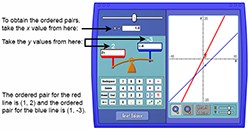Intersection of Graphed Equations
My Definition
Key Characteristics
The following are true of the intersection of graphed equations:
- It can be a point (x, y) that occurs on both graphed equations.
- It represents a solution(s) that satisfies both equations.
- Not all pairs of graphed equations will have an intersection.
- Coinciding lines will have an infinite number of intersections.
Example
Consider the two equations y = 4x and y = 2x + 6. The intersection of these two graphed equations represents a solution to both equations.
Follow the instructions below to further study examples of the intersection of graphed equations.
- 1. Go to the Intersection of Graphed Equations Activity.
- 2. Use this screen capture for instructions to obtain the ordered pairs.
- 3. Enter 4x into the left side of the balance and 2x + 6 into the right side of the balance. Move the slider for x to zero. What do you notice?
- 4. Move the slider for x to -3. What do you notice?
- 5. Move the slider for x to 3. What do you notice?
- 6. (3, 12) represents the intersection of the graphed equations y = 4x and y = 2x + 6.
- 7. Repeat steps 1 to 6 using these two equations: y = 2x; y = x - 4
- 8. Repeat steps 1 to 6 using these two equations: y = -2x - 1; y = x + 5
- 9. Repeat steps 1 to 6 using these two equations: y = 2x + 4; y = 13x - 3
Non-example
The ordered pair (2,4) is one solution to the equation y = 2x. The ordered pairs (3, 6), (4.5, 9), and (5.2, 10.4) are also solutions to the equation y = 2x.
y = 2x
4 = 2(2)
4 = 4
